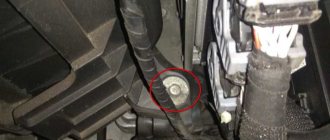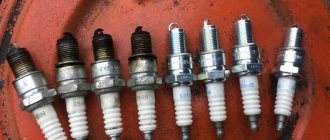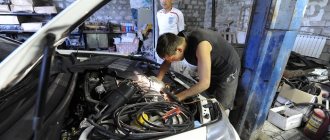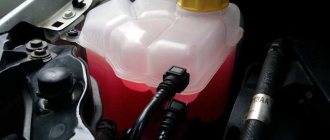Why change the timing belt?
Obviously - due to its wear and tear. But what could lead to belt damage is a more complex question, reflecting the importance of monitoring the condition of the timing belt. The pistons and valves share the same space in the engine, but, thanks to the belt, never meet each other. If the belt breaks, such a problem will occur and will result in expensive repairs. Possible damage when the timing belt breaks:
- Simply replacing the belt - such consequences are rare, more often the result is more disastrous.
- Bending of intake/exhaust valves: one or more.
- At high speeds, the valve may be knocked out and the engine housing may be deformed.
- Deformation of the piston group is extremely rare on modern cars, but such an outcome can occur.
Thus, in order not to suffer significant losses during repairs, it is better to control the timing belt and change it in a timely manner.
The engine does not start, the starter cranks idle
Well, the last option, when “it’s just too late to drink Borzhom”, is when the starter cranks idle. If you did not replace the belt in time or simply did not notice that its service life was coming to an end, and the belt broke or slipped, then you may face expensive repairs. There is only one sign - the starter spins quite vigorously (better than usual), but is idle. Now, as one joke said, there are “two ways”: replace the engine or try to revive the old one. In most cases, it will be easier to purchase a contract motor, for which the seller will provide a guarantee. In any case, you will spend a lot of money on such an event!
Used car
This is not just a sign, but a primary necessity. After buying a used car, the first thing you need to do is go to a service center and change the timing belt. Troubleshoot the tensioner, shoes, sprockets, damper, if any, for wear. Often, previous owners did not bother preparing the car for sale. Why change something if you are going to “throw away” your old car.
Do not trust the seller's assurances. He can beautifully say what you want to hear. Therefore, we do not neglect this recommendation.
Replacement Regulations
The belts of many cars can last quite a long time without replacement, and sometimes even longer than the service life declared by the manufacturer. For example, on many foreign cars the service life is stated to be 90 thousand kilometers, the belts can go up to 120. But it is better to replace the belt in advance. So, the regulation for replacing the timing belt is once every 60 thousand kilometers.
This will protect you from the unwanted consequences of a break, and the procedure will not seem so frequent.
This is what a broken timing belt looks like
Other reasons for replacement
In addition to the regulations, there are a number of other reasons why you should replace the timing belt. For example, the belt is not original or of poor quality. To avoid having to repair the engine, it is recommended to check its condition once every two months. To do this, the protective cover is removed, and the belt is inspected for damage, cracks and lint. If there are any, then the belt must be replaced.
The timing belt cannot be brought to this state.
Another reason is the expiration date of the belt. It is stamped on the belt itself in the form of 3-4 numbers. This is the production year and week. The shelf life of the belt is 5 years from the date of manufacture. If it passes, you should play it safe and replace the faulty element. The last reason is a leaking pump, due to which the belt got wet and could become damaged and jump onto a tooth. All this is accompanied by mechanical damage due to high friction. Well, don’t forget about the rollers, defects of which also reduce its service life. If the roller is skewed or begins to whistle, then it is better to immediately replace the entire timing belt repair kit.
How often should the timing belt be changed?
You can determine when to change the timing belt from the technical documentation of the car. The manufacturer always indicates the frequency of maintenance: oil changes, consumables and timing belt maintenance.
At what mileage should the timing belt be changed?
The recommended frequency is once every 50-80 thousand km. Western car manufacturers indicate a figure of 120 thousand km, but in the realities of our climate and driving conditions, the figure is noticeably reduced: to 80-100 thousand.
How long does it take to change the timing belt?
If you have not yet driven 50 thousand, dealers recommend changing the belt after 4-5 years of using the car. This is due to the fact that the belt is mostly made of rubber, which tends to dry out and crack over time.
Leaking from under the belt drive housings
Oil leaks or antifreeze leaks are another symptom of a timing belt failure . If the crankshaft oil seal is slightly worn, oil may get on the belt, and antifreeze may get on it due to leaky joints. In any case, these fluids increase wear on the belt, which means it fails faster. In the future, he may simply jump, which will also lead to serious problems. Therefore, do not delay with repairs and go to a car service center.
Visual
It is believed that a visual inspection will help determine the life of the drive. Fraying, tears, cracks, etc. They can tell you whether the belt will still “run” or break after a few kilometers.
Let's figure it out right away. The belt can not only break. The teeth on it wear out. This is fraught with its “slip” on the camshaft. The valve timing will go wrong, the engine will not only lose its power, but will also have difficulty working. In some cases, pistons and valves may meet. The result of their “union” will be a major overhaul.
The belt may not break, but “lose” several teeth
So, a visual inspection may not show wear or broken teeth. Some of them may be hidden far from your eyes. Others at this moment will be on the shaft sprockets. Everything looks good, but in reality they are already on the verge of a bummer.
Secondly, not all engines have timing belts within visual reach. Some are hidden by protective covers, which are under the front plate of the motor. Partial disassembly is required to get to them. On most BMW engines, it is necessary to “lower” the power unit in order to reach the timing belt. Having reached it, is there any point in inspecting it? – Since you are already there, it is better to replace it immediately, so as not to deal with nonsense for another 60-100 thousand km.
For example, the Opel Cadet engine belts can be easily seen by opening the hood of the car. But there are very few such models, so one can be skeptical about this sign of timing drive wear.
The timing drive of the Opel Cadet is not covered by a protective casing or front engine plate - ideal for visual inspection
What affects timing belt wear?
Several factors increase the frequency of replacement:
- Quality of components. If the last time you installed a non-original belt when servicing the timing belt, it is better to replace it after 15-20 thousand km. It is impossible after how long to change the timing belt when using non-original spare parts.
- Intensity of machine operation. If the car is used in a taxi or you use it every day for other purposes, replacement parts should be done more often.
- Increased risk of damage. If the car is operated in aggressive conditions (off-road, racing) or the belt comes into contact with other parts, the risk of rupture increases.
If possible, it is better to inspect the timing belt every 5-10 thousand kilometers, but this is not always possible due to the design features of the engine.
Preparing the machine and tools
Before you start work, you need to prepare everything you need in advance. This means stocking up on tools that may be needed, a new replacement kit, and also carrying out all the preparatory work.
First of all, prepare the place of work and the car itself:
- the working area must be level and normally lit;
- put the car on the parking brake;
- under the wheels - always stops;
- the engine must be completely cool;
- The car is de-energized and the battery terminals are removed.
Before starting to work on the engine itself, the car needs to be jacked up and everything that might interfere with getting to the timing belt must be removed.
List of necessary tools:
- standard set of open-end wrenches;
- a set of socket heads with a “ratchet”;
- fork key;
- a pair of screwdrivers (flat and Phillips);
- jack;
- sealant.
And finally, you need a new set of timing belt with rollers (its configuration depends on the car model), as well as clamps for the shafts (which ones depend on the engine itself, and this can be found in the service book), a flashlight, overalls, gloves and rags . And, of course, a phone with a camera, which will have to record the position of all the elements before they are dismantled. Believe me, this is important!
Signs of timing belt wear
When it is not possible to inspect the belt, you can be guided by characteristic signs of wear.
- When starting the engine, strong vibrations or a drop in thrust . This indicates that the belt is poorly tensioned or has slipped one or more teeth.
- Black smoke from the exhaust system. A worn belt is one possible cause.
- Fluid leaks near the drive. If technical fluids get on the belt, its service life is reduced.
It is not easy to determine the replacement of the timing belt; all symptoms may indicate other problems, but if they occur, do not delay in contacting specialists.
Determining the need to replace the timing chain
As the need to replace the chain approaches, it lengthens significantly. A consumable rupture occurs extremely rarely. This is especially true for double-row chains. You can determine the presence of an extension by measuring the consumable. It will be much longer than the new product.
Comparison of new and old chain lengths
When the chain stretches, the tensioner tries to eliminate its elongation. It can be either manual or automatic. The elongation of the chain is determined by the output of its piston.
Tensioner with chain stretched
You can check for chain stretch by pulling it on the camshaft gear. If it rises by a centimeter or more, then there is a risk of the teeth jumping and such a consumable must be replaced.
Stretched camshaft chain and gear
When the timing chain stretches, a number of external symptoms of the need for replacement appear. There is a metallic knock coming from the timing drive side. It is most noticeable on a cold engine after starting. With more severe chain wear, a timing shift occurs. The engine loses power, fuel consumption increases, and the speed becomes unstable.
Modern cars have a self-diagnosis system that receives information from sensors. A symptom of the need to replace the chain is the presence of errors in the operation of the crankshaft and camshaft sensors. You can check for problems using a diagnostic scanner.
Information about errors in the operation of the crankshaft and camshaft
To eliminate errors from the sensors themselves, it is recommended to take oscillograms of the timing belt operation. By counting them, you can see obvious symptoms of the need to replace the timing chain.
Oscillograms of timing belt operation











